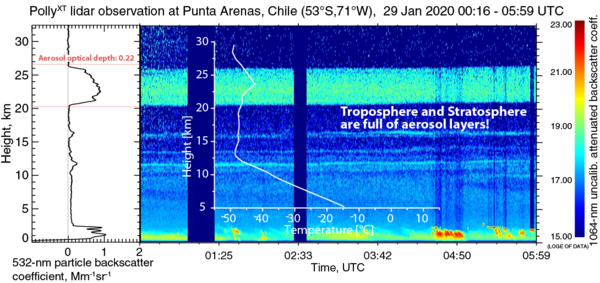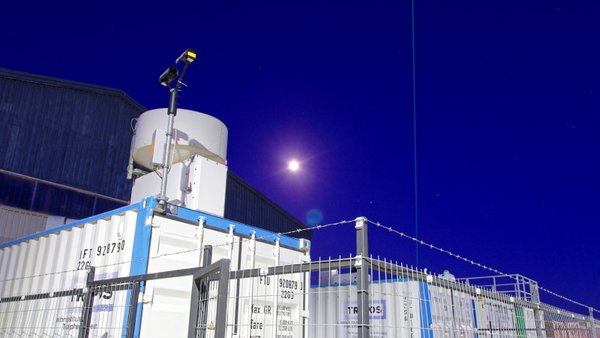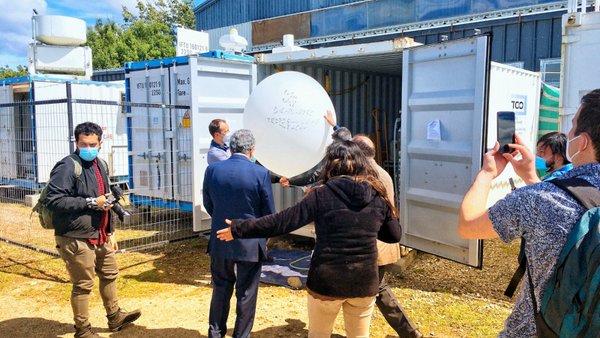Updrafts crucial - clouds in the southern hemisphere more precisely understood
Leipzig,
26.01.2022
Longest dataset of lidar-radar observations in the mid-latitudes of the southern hemisphere provides new insights into the differences to northern-hemispheric clouds
Punta Arenas/Leipzig. Clouds in the southern hemisphere reflect more sunlight than those in the northern hemisphere. The reason is a more frequent occurrence of liquid water droplets, which results from an interplay between updrafts and a cleaner environment. In a study published in the journal Atmospheric Chemistry and Physics, a team of researchers led by the Leibniz Institute for Tropospheric Research (TROPOS) found a stronger influence of updrafts than expected. The new results were made possible by long-term measurements in Leipzig (Germany), Limassol (Cyprus) and Punta Arenas (Chile).
Covering three years, the measurements in Punta Arenas are the longest dataset on cloud properties obtained with ground-based lidar and radar in the Southern Ocean. From 2018 to 2021, an international team from University of Magallanes (UMAG), TROPOS and University of Leipzig had conducted extensive observations of aerosols, clouds, wind and precipitation in the very south of Chile as part of the DACAPO-PESO field experiment. The researchers used two datasets from the northern hemisphere locations of Leipzig and Cyprus to put their findings into global context. Data from the CyCARE field campaign on Cyprus were collected in the years 2016 to 2018 in collaboration with researchers from the Cyprus University of Technology and the ERATOSTHENES Centre of Excellence in Limassol.
The main objective of the measurements in the pristine environment at the southern tip of South America was to study the atmosphere and to learn more about the interactions between aerosols and clouds in a region where there is hardly any long-term data available so far. To address the lack of observations, TROPOS brought the two containers of the LACROS mobile atmospheric observatory together with instrumentation of the University of Leipzig to Punta Arenas. There, the observations were conducted together with UMAG's Laboratory for Atmospheric Research. The instrumentation of LACROS consists of multiple lidars, radars, radiometers, sun photometers and others. These measurements were supplemented by aerosol filter samples from Cerro Mirador, a 600 m high hill close by.
Originally, the measurements were planned for one year as a contribution to the "Year of Polar Prediction in the Southern Hemisphere" (YOPP-SH). But due to the global COVID-19 pandemic and the resulting travel restrictions, the measurements were extended by two years and only finished at the end of 2021. "Scientifically, this delay was of great benefit," says Kevin Ohneiser, PhD student at TROPOS. Because the huge "Black Summer" wildfires of 2019/20 occurred in Australia during this period. Their smoke was transported more than 10,000 kilometres across the Pacific to South America and could be observed there up to heights of 25 km with the laser-based investigations until the measurements were completed at the end of 2021. Since the air in southern Chile is usually very clean, this type of air pollution was immediately noticeable and underlines the global influence of the large forest fires on climate.
"With DACAPO-PESO, we have filled a gap in measurements that has long existed for the southern hemisphere. The freely available data can now help to improve current climate models," explains Dr Boris Barja from UMAG, who played a decisive role on-site in ensuring that the instruments could be in continuous operation despite the Covid-19-related travel restrictions.
With more than 10 follow-up projects, 20 conference papers and 10 research publications to date, the project has been very successful scientifically. Further publications are close to finalization. Teresa Vogl, Phd student from University of Leipzig, for instance, is currently working on a method to characterize precipitation formation with a machine learning-based cloud radar algorithm.
The recently achieved main purpose of the project was however to investigate the differences of thin cloud layers over Leipzig, Limassol and Punta Arenas. Due to a high percentage of oceans covering the Earth in the southern hemisphere, the atmosphere in this region is cleaner, i.e. contains fewer aerosol particles. This difference is especially strong in the free troposphere - the air masses at higher altitudes, unaffected from local pollution sources. "Fewer particles mean fewer ice nuclei in the atmosphere. But it is precisely these that are needed to cause cloud droplets to freeze into ice crystals at temperatures between 0 and -40°C. Therefore, clouds ice up much less in the mid-latitudes of the southern hemisphere and contain more liquid water at the same temperatures. This means that they influence the incident sunlight and also the thermal radiation emitted from the Earth's surface differently than in the north. This is one explanation why global climate models are still not able to represent the radiation balance of the southern hemisphere with sufficient accuracy," summarises Dr Patric Seifert from TROPOS. In the temperature range between -24 and -8°C, the lack of ice nuclei caused the clouds over Punta Arenas to form ice on average 10 to 40 percent less often than the clouds over Leipzig. The ice mass produced by the liquid water clouds is also reduced by at least a factor of 2.
However, contrary to previous studies, differences in atmospheric pollution are not the only cause of the observed contrasts, especially at even lower temperatures. The investigations in southern Chile showed that the clouds are often influenced by so-called gravity waves. The strong westerly wind from the Pacific collides with the Andes mountains, is displaced upwards and creates these gravity waves. "By measuring the up- and downward winds within the clouds, we were able to detect clouds that had been influenced by these waves and filter them out of the overall statistics. This allowed us to show that these gravity waves, and not the lack of ice nuclei, are mainly responsible for the excess of cloud droplets at temperatures below -25°C," explains Dr Martin Radenz from TROPOS, who recently obtained the Phd degree for his work on this subject. " However, it is currently unclear whether this phenomenon only influences clouds in southern Chile. How important are gravity waves for the formation of clouds and precipitation in other regions of the Southern Ocean? How often do gravity waves occur over the open ocean, which covers most of the Earth's surface between 30 and 70 degrees south and is currently only observed by satellites? Further measurements of air motion in clouds are needed to further constrain the role of ice nuclei in the apparent excess of liquid water in clouds. In the near future, we plan to work with our partners to investigate these questions at other locations in the Southern Hemisphere, such as Antarctica and New Zealand, and ideally also from aboard research vessels. Because from space those observations are not possible at the moment."
The two LACROS containers will be back at TROPOS in Leipzig at the end of January and will then be prepared for their next deployment. Within the framework of ACTRIS-D, the German contribution to the European research infrastructure for aerosols, clouds and trace gases, three new instruments will then be integrated. With a new sun photometer, microwave radiometer and 94 Ghz cloud radar, LACROS will go to the Swiss Alps in November to investigate artificially generated ice clouds. Tilo Arnhold
Media contacts:
Dr Patric Seifert, Dr Martin Radenz, Dr Albert Ansmann, Dr Johannes Bühl
Working Group „Ground-based Remote Sensing“ at the
Leibniz Institute for Tropospheric Research (TROPOS)
Phone: +49-341-2717-7080, -7312, -7064, -7312
https://www.tropos.de/en/institute/about-us/employees/patric-seifert
https://www.tropos.de/en/institute/about-us/employees/martin-radenz
https://www.tropos.de/en/institute/about-us/employees/albert-ansmann/
https://www.tropos.de/en/institute/about-us/employees/johannes-buehl
or
Tilo Arnhold
TROPOS Public Relations
Phone: +49-341-2717-7189
https://www.tropos.de/en/current-issues/press-releases
as well as
Jun.-Prof. Heike Kalesse-Los
Working Group "Remote Sensing and the Arctic System" at the
Leipzig Institute for Meteorology (LIM) at Leipzig University
Phone: +49-341-97-36650
https://www.uni-leipzig.de/en/profile/mitarbeiter/juniorprof-dr-heike-kalesse-los
oder
Susann Huster
Media Team, Leipzig University
Phone: +49-341-97-35022
https://www.uni-leipzig.de/en/university/structure/administration-and-offices/office-for-university-communications
Links:
Project “Dynamics, Aerosol, Cloud and Precipitation Observations in the Pristine Environment of the Southern Ocean” (DACAPO-PESO):
https://dacapo.tropos.de/
Australian forest fires are felt as far away as Chile (short news, 06 Jan 2020):
https://www.tropos.de/en/current-issues/press-releases/kurzmitteilungen/rauch-aus-australien
Field experiment on clouds and precipitation under clean air conditions started in southern Chile (press release, 20 Dec2018):
https://www.tropos.de/en/current-issues/press-releases/details/field-experiment-on-clouds-and-precipitation-under-clean-air-conditions-started-in-southern-chile
Leipzig Aerosol and Clouds Remote Observations System (LACROS):
https://www.tropos.de/forschung/grossprojekte-infrastruktur-technologie/koordinierte-beobachtungen-und-netzwerke/lacros
Worldwide observations with the portable Raman lidar systems (Polly)
https://polly.tropos.de/
Publication:
Radenz, M., Bühl, J., Seifert, P., Baars, H., Engelmann, R., Barja González, B., Mamouri, R.-E., Zamorano, F., and Ansmann, A.: Hemispheric contrasts in ice formation in stratiform mixed-phase clouds: disentangling the role of aerosol and dynamics with ground-based remote sensing, Atmos. Chem. Phys., 21, 17969–17994, https://doi.org/10.5194/acp-21-17969-2021 , 2021. (08 Dec 2021)
The research was funded by the European Commission (H2020 Research Infrastructures (grant nos. 654109 and 857510), the EU Seventh Framework Programme (grant no. 603445)), the German Federal Ministry of Education and Research (BMBF; "High Definition Clouds and Precipitation for Climate Prediction HD(CP)2" (grant nos. 01LK1503F, 01LK1502I, 01LK1209C, and 01LK1212C)), the German Research Foundation (DFG; grant nos. SE2464/1-1, KA4162/2-1, and 39828502), the EU/Cyprus Research and Innovation Foundation (EXCELLENCE/1216/0217, ANID/CONICYT/FONDECYT Iniciación (grant no. 11181335)) and the German Federal Ministry for Economic Affairs and Energy (BMWi; grant no. 50EE1721C).
Further publications:
Ansmann, A., Ohneiser, K., Mamouri, R.-E., Knopf, D. A., Veselovskii, I., Baars, H., Engelmann, R., Foth, A., Jimenez, C., Seifert, P., and Barja, B.: Tropospheric and stratospheric wildfire smoke profiling with lidar: mass, surface area, CCN, and INP retrieval, Atmos. Chem. Phys., 21, 9779–9807, https://doi.org/10.5194/acp-21-9779-2021 , 2021. (29 Jun 2021)
Jimenez, C., Ansmann, A., Engelmann, R., Donovan, D., Malinka, A., Seifert, P., Wiesen, R., Radenz, M., Yin, Z., Bühl, J., Schmidt, J., Barja, B., and Wandinger, U.: The dual-field-of-view polarization lidar technique: a new concept in monitoring aerosol effects in liquid-water clouds – case studies, Atmos. Chem. Phys., 20, 15265–15284, https://doi.org/10.5194/acp-20-15265-2020 , 2020. (08 Dec 2020)
Bromwich, D.H., Werner, K., Casati, B., Powers, J.G., Gorodetskaya, I.V., Massonnet, F., Vitale, V., Heinrich, V.J., Liggett, D., Arndt, S., Barja, B., Bazile, E., Carpentier, S., Carrasco, J.F., Choi, T., Choi, Y., Colwell, S.R., Cordero, R.R., Gervasi, M., Haiden, T., Hirasawa, N., Inoue, J., Jung, T., Kalesse, H., Kim, S.-J., Lazzara, M.A., Manning, K.W., Norris, K., Park, S.-J., Reid, P., Rigor, I., Rowe, P.M., Schmithüsen, H., Seifert, P., Sun, Q., Uttal, T., Zannoni, M., Zou, X.: The Year of Polar Prediction in the Southern Hemisphere (YOPP-SH). Bulletin of the American Meteorological Society 101, E1653–E1676. https://doi.org/10.1175/BAMS-D-19-0255.1 , 2020.(12 Oct 2020)
Ohneiser, K., Ansmann, A., Baars, H., Seifert, P., Barja, B., Jimenez, C., Radenz, M., Teisseire, A., Floutsi, A., Haarig, M., Foth, A., Chudnovsky, A., Engelmann, R., Zamorano, F., Bühl, J., and Wandinger, U.: Smoke of extreme Australian bushfires observed in the stratosphere over Punta Arenas, Chile, in January 2020: optical thickness, lidar ratios, and depolarization ratios at 355 and 532 nm, Atmos. Chem. Phys., 20, 8003–8015, https://doi.org/10.5194/acp-20-8003-2020 , 2020. (10 Jul 2020)
Vogl, T., Maahn, M., Kneifel, S., Schimmel, W., Moisseev, D., and Kalesse-Los, H.: Using artificial neural networks to predict riming from Doppler cloud radar observations, Atmos. Meas. Tech. Discuss. [preprint], doi.org/10.5194/amt-2021-137, in review, 2021.
The Leibniz Institute for Tropospheric Research (TROPOS) is a member of the Leibniz Association, which connects 97 independent research institutions that range in focus from the natural, engineering and environmental sciences via economics, spatial and social sciences to the humanities. Leibniz Institutes address issues of social, economic and ecological relevance. They conduct knowledge-driven and applied basic research, maintain scientific infrastructure and provide research-based services.
The Leibniz Association identifies focus areas for knowledge transfer to policy-makers, academia, business and the public. Leibniz institutions collaborate intensively with universities – in the form of “Leibniz ScienceCampi” (thematic partnerships between university and non-university research institutes), for example – as well as with industry and other partners at home and abroad.
They are subject to an independent evaluation procedure that is unparalleled in its transparency. Due to the importance of the institutions for the country as a whole, they are funded jointly by the Federation and the Länder, employing some 20,500 individuals, including 11,500 researchers.
The entire budget of all the institutes is approximately 2 billion euros. They are financed jointly by the Federal Government and the Länder. The basic funding of the Leibniz Institute for Tropospheric Research (TROPOS) is therefore financed by the Federal Ministry of Education and Research (BMBF) and the Saxon State Ministry of Science and the Arts (SMWK). The Institute is co-financed with tax revenues on the basis of the budget approved by the Saxon State Parliament.
www.leibniz-gemeinschaft.de/en/home/
www.bmbf.de/en/index.html
https://www.smwk.sachsen.de/








